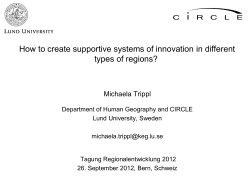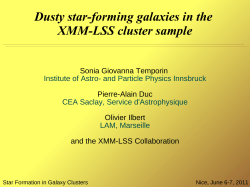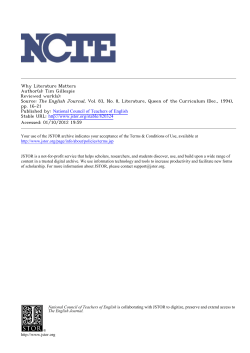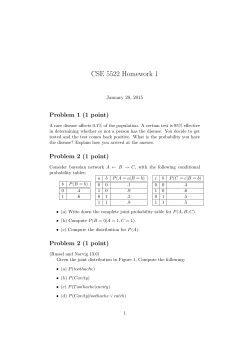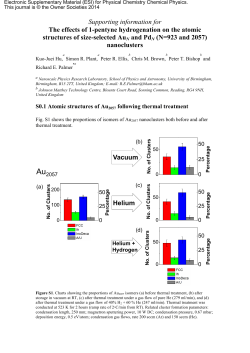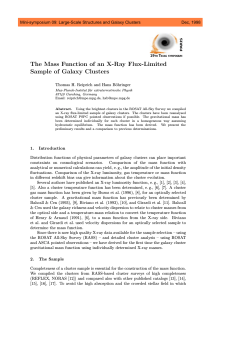
Stellar Populations and Dynamical Properties of
Stellar Populations and Dynamical Properties of Clusters in M31 Author(s): Song Wang Source: Publications of the Astronomical Society of the Pacific, Vol. 126, No. 943 (September 2014), pp. 882-883 Published by: The University of Chicago Press on behalf of the Astronomical Society of the Pacific Stable URL: http://www.jstor.org/stable/10.1086/678320 . Accessed: 02/04/2015 03:44 Your use of the JSTOR archive indicates your acceptance of the Terms & Conditions of Use, available at . http://www.jstor.org/page/info/about/policies/terms.jsp . JSTOR is a not-for-profit service that helps scholars, researchers, and students discover, use, and build upon a wide range of content in a trusted digital archive. We use information technology and tools to increase productivity and facilitate new forms of scholarship. For more information about JSTOR, please contact support@jstor.org. . The University of Chicago Press and Astronomical Society of the Pacific are collaborating with JSTOR to digitize, preserve and extend access to Publications of the Astronomical Society of the Pacific. http://www.jstor.org This content downloaded from 159.226.171.23 on Thu, 2 Apr 2015 03:44:46 AM All use subject to JSTOR Terms and Conditions PUBLICATIONS OF THE ASTRONOMICAL SOCIETY OF THE PACIFIC, 126:882–883, 2014 September © 2014. The Astronomical Society of the Pacific. All rights reserved. Printed in U.S.A. Dissertation Summary Stellar Populations and Dynamical Properties of Clusters in M31 SONG WANG National Astronomical Observatories, Chinese Academy of Sciences, Beijing 100012, China; songw@bao.ac.cn Received 2014 July 23; accepted 2014 July 30; published 2014 August 18 models. We made a discussion on some basic properties for the sample young clusters (<2 Gyr). The results implied to us the following: Star clusters are considered important tracers for understanding the formation and evolution of their host galaxies (San et al. 2010). The Andromeda galaxy (M31), which is the nearest (∼780 kpc) and largest spiral galaxy in our local group, contains numerous star clusters. So, M31 offers an ideal laboratory for studying the star cluster system. In this thesis, the dynamical parameters and the ages and masses of clusters in M31 were derived, aiming to provide useful information for studying the stellar populations and dynamical properties of clusters in M31. The discussion of the evolution history of M31 also may provide clues for the formation and evolution of our Milky Way (MW) and other galaxies. The Hubble Space Telescope (HST) provides high-resolution images for star clusters in M31. We presented surface brightness profiles using HST observations for 79 clusters and derived the structural and dynamical parameters by fitting the profiles to different dynamical models. In the majority of cases, the King models (King 1966) fit the M31 clusters as well as the Wilson models (Wilson 1975), and better than the Sérsic models (Sérsic 1968). We discussed the properties of clusters in M31, combined with globular clusters (GCs) in the MW. In general, the properties of the M31 and the Galactic clusters fall in the same regions of parameter spaces. However, there is a bimodality in the size distribution of M31 clusters at large radii, which is different from their Galactic counterparts. There are 11 clusters in M31, best fitted by Sérsic models with index n > 2, indicating that they have cuspy central density profiles, which may be core-collapsed cluster candidates. The tight correlations of cluster properties indicate a tight fundamental plane for clusters, regardless of their ages and host environments. The tightness of the relations for the internal properties reflects some universal physical conditions and processes during cluster formation. The formation and disruption of young star clusters represent a latter-day example of the hierarchical formation of galaxies (Fall 2004). Here, we determined the ages and masses for a sample of M31 young clusters by comparing the multicolor photometry, including the GALEX (Galaxy Evolution Explorer) FUV and NUV, broadband UBV RI, SDSS (Sloan Digital Sky Survey) ugriz, BATC (Beijing-Arizona-Taiwan-Connecticut) 15 intermediate-band, and 2MASS (Two Micron All Sky Survey) JHK s magnitudes, with theoretical stellar population synthesis 1. There are two distinct peaks in the age distribution, with the highest peak at age ∼60 Myr and a secondary peak around 250 Myr, while the mass distribution shows a single peak around 104 M ⊙ . 2. There are several regions showing aggregations of young clusters around the “10 kpc ring” and the “outer ring,” indicating that the distribution of the young clusters correlates well with M31’s star-forming regions. 3. The ages and masses show apparent correlations with some dynamical parameters. A few young clusters have two-body relaxation times greater than their ages, indicating that they have not been well relaxed dynamically. We argued that these young clusters have not established thermal equilibrium. 4. The young massive clusters (YMCs, age ≤100 Myr, mass ≥104 M ⊙ ) show obvious aggregation around the “ring splitting region,” as displayed in Figure 1, suggesting a high efficiency of star formation, possibly triggered by the recent passage of a satellite galaxy (M32) through the M31 disk (Block et al. 2006; Gordon et al. 2006). We performed JHK s photometric measurements for 913 GCs and candidates in the field of M31 based on 2MASS images. The sample star clusters in M31 were selected from RBC, version 5, which is the latest Revised Bologna Catalog of M31 GCs and candidates. The JHK s photometric measurements here supplement this catalog and provide a most comprehensive and homogeneous photometric catalog for M31 GCs in the JHK s bandpasses. Based on detailed comparisons, our photometry is in good agreement with previous measurements. We presented some statistical analysis based on the sample clusters, and the results showed us the following: 1. The peaks of the globular cluster luminosity function (GCLF) for the confirmed GCs derived by fitting a t5 distribution using the maximum likelihood method are: J 0 ¼ 15:348 mag, H 0 ¼ 14:703 mag, and K s0 ¼ 14:534 mag, which agree well with previous studies. 2. With the division of the confirmed GCs by both galactocentric distance and metallicity, we found that the GCLFs are 882 This content downloaded from 159.226.171.23 on Thu, 2 Apr 2015 03:44:46 AM All use subject to JSTOR Terms and Conditions 883 Y (kpc) POPULATIONS & DYNAMICAL PROPERTIES OF M31 CLUSTERS X (kpc) FIG. 1.—Spatial distribution for YMCs, drawn with the different sizes of the open circles indicating different mass ranges. The inner, solid ellipse and the dashed contour represent the “10 kpc ring” and the “outer ring,” while the dotted ellipse is the M31 disk/halo boundary. The small rectangle represents the “ring splitting region” in the southern part of M31 disk, and the two filled black triangles represent M32 and NGC 205. different between metal-rich (MR) and metal-poor (MP) and between inner and outer subpopulations. Generally, MP clusters are fainter than their MR counterparts, and the inner clusters are brighter than the outer ones, which confirm previous results. 3. The near-infrared red (NIR) colors of the GC candidates are on average redder than those of the confirmed GCs, which leads to a weak bimodal distribution of the color indices, as shown in Figure 2. FIG. 2.—NIR color distribution of the sample star clusters. 4. The relation of ðV K s Þ0 mag and metallicity shows an obvious departure from linearity, with a shallower slope towards the redder end. 5. The color-magnitude diagram (CMD) and color-color diagram show that many GC candidates are located out of the evolutionary tracks, indicating that some of them may not be true GCs. The CMD also shows that the initial mass of M31 clusters covers a large range, and the majority of the clusters have initial masses between 103 and 106 M ⊙ . REFERENCES Block, D. L., et al. 2006, Nature, 443, 832 Fall, S. M. 2004, in ASP Conf. Ser. 322, The Formation and Evolution of Massive Young Star Clusters, ed. H. J. G. L. M. Lamers, L. J. Smith, & A. Nota (San Francisco: ASP), 399 Gordon, K. D., et al. 2006, ApJ, 638, L 87 King, I. R. 1966, AJ, 71, 64 San Roman, I., Sarajedini, A., & Aparicio, A. 2010, ApJ, 720, 1674 Sérsic, J.-L. 1968, Atlas de Galaxias Australes (Cordoba: Obs. Astronomico) Wilson, C. P. 1975, AJ, 80, 175 2014 PASP, 126:882–883 This content downloaded from 159.226.171.23 on Thu, 2 Apr 2015 03:44:46 AM All use subject to JSTOR Terms and Conditions
© Copyright 2025

